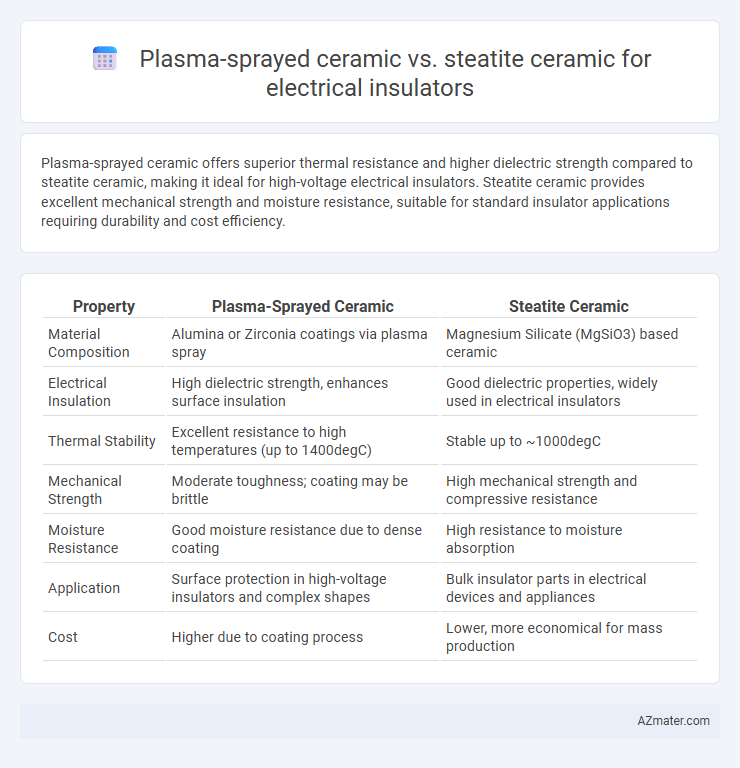Plasma-sprayed ceramic offers superior thermal resistance and higher dielectric strength compared to steatite ceramic, making it ideal for high-voltage electrical insulators. Steatite ceramic provides excellent mechanical strength and moisture resistance, suitable for standard insulator applications requiring durability and cost efficiency.
Table of Comparison
| Property | Plasma-Sprayed Ceramic | Steatite Ceramic |
|---|---|---|
| Material Composition | Alumina or Zirconia coatings via plasma spray | Magnesium Silicate (MgSiO3) based ceramic |
| Electrical Insulation | High dielectric strength, enhances surface insulation | Good dielectric properties, widely used in electrical insulators |
| Thermal Stability | Excellent resistance to high temperatures (up to 1400degC) | Stable up to ~1000degC |
| Mechanical Strength | Moderate toughness; coating may be brittle | High mechanical strength and compressive resistance |
| Moisture Resistance | Good moisture resistance due to dense coating | High resistance to moisture absorption |
| Application | Surface protection in high-voltage insulators and complex shapes | Bulk insulator parts in electrical devices and appliances |
| Cost | Higher due to coating process | Lower, more economical for mass production |
Introduction to Electrical Insulators
Plasma-sprayed ceramic coatings offer enhanced dielectric strength and thermal resistance compared to traditional Steatite ceramic, making them suitable for high-voltage electrical insulators. Steatite ceramic provides good electrical insulation with excellent mechanical strength and low dielectric losses, often used in medium-voltage applications. The choice between plasma-sprayed and Steatite ceramics depends on operational requirements such as temperature tolerance, voltage levels, and environmental conditions.
Overview of Plasma-Sprayed Ceramic Insulators
Plasma-sprayed ceramic insulators provide superior thermal stability and electrical insulation due to their dense, uniform coating formed by high-temperature plasma jet deposition. This technique produces a microstructure with enhanced resistance to thermal shock and abrasion compared to traditional Steatite ceramic, which is valued for its machinability and lower dielectric losses but lacks the same level of toughness. The plasma-sprayed ceramic coatings are particularly effective in high-voltage and harsh environment applications, offering improved dielectric strength and longer service life.
Properties of Steatite Ceramic Insulators
Steatite ceramic insulators offer high dielectric strength and excellent electrical insulation properties, making them suitable for high-voltage applications. They exhibit low thermal expansion and superior resistance to mechanical stress, thermal shock, and moisture compared to plasma-sprayed ceramic coatings. The inherent chemical stability and machinability of steatite ceramics enhance their durability and precision in electrical insulation components.
Manufacturing Processes: Plasma-Sprayed vs Steatite Ceramics
Plasma-sprayed ceramic insulators are manufactured through a thermal spray process that involves melting ceramic powders and propelling them onto a substrate, resulting in a dense, adherent coating with controlled microstructure and porosity. In contrast, Steatite ceramic insulators undergo a classical shaping method involving powder pressing and high-temperature sintering, producing a dense, homogenous bulk material with superior mechanical strength and dielectric properties. The plasma-spraying process offers greater flexibility in coating complex geometries and thickness control, while Steatite ceramics provide enhanced structural integrity and resistance to thermal shock due to their fully sintered matrix.
Electrical Performance Comparison
Plasma-sprayed ceramic insulators exhibit superior electrical performance characterized by higher dielectric strength and improved resistance to surface leakage currents compared to steatite ceramic insulators. Steatite ceramics, while cost-effective and mechanically robust, generally show lower breakdown voltage and increased susceptibility to electrical degradation under prolonged high-voltage stress. The enhanced microstructural homogeneity and dense ceramic coatings achieved through plasma spraying contribute to reduced porosity and enhanced insulation reliability in high-voltage applications.
Mechanical Strength and Durability
Plasma-sprayed ceramic coatings exhibit superior mechanical strength and enhanced durability compared to steatite ceramic in electrical insulators due to their denser microstructure and strong adhesion properties. Steatite ceramic, primarily composed of magnesium silicate, offers good dielectric properties but tends to have lower fracture toughness and is more susceptible to crack propagation under mechanical stress. The high-temperature resistance and wear resistance of plasma-sprayed ceramics make them more reliable for high-stress electrical insulation applications.
Thermal Properties and Resistance
Plasma-sprayed ceramic insulators exhibit superior thermal stability with operating temperatures often exceeding 1200degC, compared to steatite ceramics that typically withstand up to 1000degC. The plasma-sprayed coatings offer enhanced thermal shock resistance due to their fine microstructure and strong adhesion to substrates, minimizing crack formation under rapid temperature changes. Steatite ceramics provide good dielectric strength around 15-20 kV/mm but generally have lower resistance to thermal cycling and mechanical stresses than plasma-sprayed ceramics, making the latter ideal for high-temperature, high-stress electrical insulation applications.
Cost Analysis and Economic Viability
Plasma-sprayed ceramic electrical insulators generally exhibit higher initial production costs than steatite ceramic due to advanced equipment and specialized processing requirements. However, the enhanced durability, superior thermal resistance, and improved dielectric properties of plasma-sprayed ceramics lead to lower maintenance expenses and longer service life, increasing overall economic viability. Steatite ceramics offer cost advantages in bulk manufacturing but may incur higher replacement and downtime costs, making plasma-sprayed options economically preferable for high-performance, long-term insulation applications.
Applications in Electrical Engineering
Plasma-sprayed ceramic coatings offer superior thermal resistance and electrical insulation properties, making them ideal for high-voltage and high-temperature applications in electrical engineering, such as insulators in power transformers and switchgear. Steatite ceramic, known for its excellent dielectric strength and mechanical robustness, is widely used in capacitors, spark plugs, and insulating supports where cost-effectiveness and reliability are critical. Both materials provide essential insulation solutions, but plasma-sprayed ceramics excel in demanding environments requiring enhanced durability and thermal stability.
Conclusion: Choosing the Optimal Ceramic Insulator
Plasma-sprayed ceramic insulators offer superior thermal resistance and enhanced mechanical strength compared to steatite ceramics, making them ideal for high-temperature and high-stress electrical applications. Steatite ceramics provide excellent electrical insulation properties, cost-effectiveness, and good dielectric strength, suitable for lower-stress environments. Selecting the optimal ceramic insulator depends on balancing application-specific requirements such as operating temperature, mechanical load, dielectric properties, and budget constraints.

Infographic: Plasma-sprayed ceramic vs Steatite ceramic for Electrical insulator
 azmater.com
azmater.com